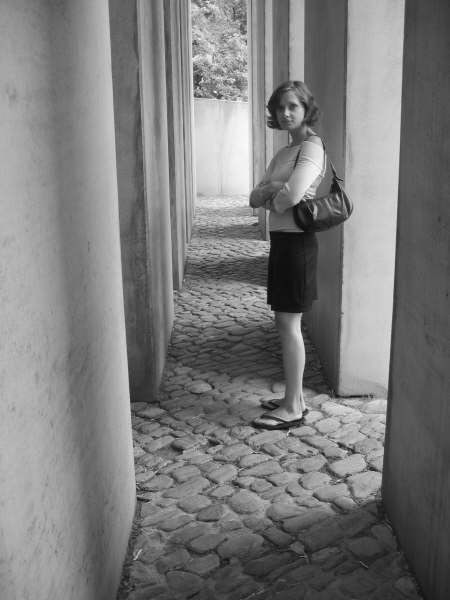 I wrote my "inspiration" entry, below, about a week ago. I saved it as a draft. I was going to comment, in it, on how my ideas about the power of material culture had changed since I'd started in Western's Public History program. I was going to write that our first sets of readings and our seminar discussions had made me realize that an institution's online exhibit (such as the Canadian Museum of Civilization's Citizens virtual exhibit) is, fundamentally, a very different thing than an actual, on-site exhibition. It seemed a bit of a fleeting thought, and so I left it at that. In the course of this week, I have encountered a lot of information - all of which was entirely new to me - on material culture, social tagging and democratization of curatiorial functions. I'd like to reflect on my "inspiration" from the new perspective that the week's learning has afforded me.
I wrote my "inspiration" entry, below, about a week ago. I saved it as a draft. I was going to comment, in it, on how my ideas about the power of material culture had changed since I'd started in Western's Public History program. I was going to write that our first sets of readings and our seminar discussions had made me realize that an institution's online exhibit (such as the Canadian Museum of Civilization's Citizens virtual exhibit) is, fundamentally, a very different thing than an actual, on-site exhibition. It seemed a bit of a fleeting thought, and so I left it at that. In the course of this week, I have encountered a lot of information - all of which was entirely new to me - on material culture, social tagging and democratization of curatiorial functions. I'd like to reflect on my "inspiration" from the new perspective that the week's learning has afforded me.In the photo on the right, Mark stands on one of the many columns at Berlin's Holocaust Memorial. Some of these columns are almost 5 metres tall. Mark and I hopped across the tops of them. This is a dumb thing to do. A month before our trip, a drunk man fell doing the same. (Apparently, the memorial's governing body forbids column hopping). Nevertheless, that was how we interacted with the memorial. Others interacted with it in very different ways. Some used the shorter stelae as benches. Kids ran around the narrow pathways playing hide-and-go-seek. I turned a corner and almost ran into a woman who stood, still and alone, in the middle of a pathway and in the shadow of some of the tallest columns.
We read, this week, a definition of material culture. It is, to crudely paraphrase Thomas J. Schlereth, stuff that has been purposely shaped according to culturally dictated plans. Our aim in examining it is to develop an explanatory of this stuff - that is, we hope to learn what we can about people in the past from this stuff [1]. But, asked another author, is "stuff" encoded with cultural information, or is it neutral - and its meaning only comes from past individuals', or groups', use of it? [2]
Let's look at this issue from another angle, and come back to the memorial example. The American scholar James E. Young has published much work on Holocaust memorials and meaning. He has written that there is no intrinsic meaning in memorials. Instead, they derive their meaning from visitors' interactions. Each visitor makes her own experience of memory at a memorial. So goes the line of thought, anyway.
Isn't this the kind of thing we're talking about when we discuss whether or not the social tagging of museum collections - such as at the steve.museum research project - undermine museums', or their curators', cultural authority? I'm remembering, specifically, when Adam mentioned in seminar today that social tagging doesn't affect the real-life object. (For example, user Yogi can tag his Flickr photos utatathursdaywalk23, but that descriptor is really only a reality in the digital world - not in the real world). I thought Bryan's anxiety about separating the digital from the real world, and Tea's response about hyperreality really interesting. These comments cast my mind back to the example of the memorial (that, it seems, is always festering away in the back of my mind).
I'm sure that I interpret the memorial in a way that noone else has, does, or will. I could make public an indication of the way I interpret the memorial by tagging a (hypothetical) Flickr collection awesomecementjunglegym. That might be my genuine reaction to the memorial - my own memorial activity. When I publish this tag online, I'm creating a representation of the actual memorial in Berlin. Where I suppose I'm still torn is if I should be free to publish any representation of the memorial online. At the beginning of our seminar, Bryan suggested that, once someone ascribes a tag to a museum artefact, for example, the possibility exists that I can come across that tag. In so doing, even though I might never have associated that object with that descriptor myself, I might not be able to avoid assimilating that tag's meaning into my understanding of the object. Is this dangerous? Could social tagging, implemented in a museum's online collection, undermine the institution's cultural authority? Does it have the potential to spread stupid ideas around (such as that the Holocaust memorial is an awesomecementjunglegym - perhaps it is, but only to the tourist equipped with a helmet and full body cushioning)?
I appreciate the incredible potential of tagging practices for museums, and genuinely think that they can tell an institution much about what kind of product their public demands. I do, also, believe that an artefact's meaning comes from the meaning that people in the past conferred on it. Further, I think that our present interaction with material from the past confers another important layer of meaning on pieces of material culture. What I'm left with at the end of this muddy reflection is a belief that multiple sets of meaning intersect at an artefact. What can be lost, then, when we don't have one "expert"individual, or body, that remains mindful of this reality, that manages the meanings conferred, and that reminds us all of the artefact's broad cultural and historic context (beyond individual, isolated and potentially highly subjective interpretations)?
[1] Thomas J Schlereth, "Material Culture and Cultural Research," from Material Culture: A Research Guide (University Press of Kansas, 1985), 1-34.
[2] Carroll W Pursell Jr., "The History of Technology and the Study of Material Culture," from Material Culture, 113-26.
Tags: social bookmarking, memorial, cultural authority, curator, steve.museum

1 comment:
Hmmm....the material culture discussion is blowing my mind.
In light of this week's readings, I'm interested in whether or not you think the Memorial to the Murdered Jews of Europe (as a physical, created object/thing) in any way limits the meaning that people can assign to it.
I suppose that the range of aesthetic responses to an object can be nearly infinite, but in this case, the aesthetic object is MEMORIALIZING something. So their must be some intention and meaning within the object, even if its creator (Eisenman) tried to avoid overtly symbolic or realistic representations.
So I'm curious about what meaning you took from the memorial. You talked about using the stelae as a jungle gym- this was perhaps an aesthetic response, as sensual response- but how did that translate into your understanding of the event/memory that the memorial is memorializing?
So, yeah- When we look at a piece of art, an artefact or even an historical event, can we ascribe ANY meaning to it that we want to (as in "willy-nilly" tagging?) Of course we CAN, but if we really attend to the object, does it somehow limit our interpretation?
I agree with you that there are many layers of meaning. There's no "right" answer, but are their some wrong ones? (eek! And I'm really interested in what meaning you took from the memorial. I wasn't in any way trying to suggest that yours was a 'wrong' one!) Keep it comin'! m.
Post a Comment